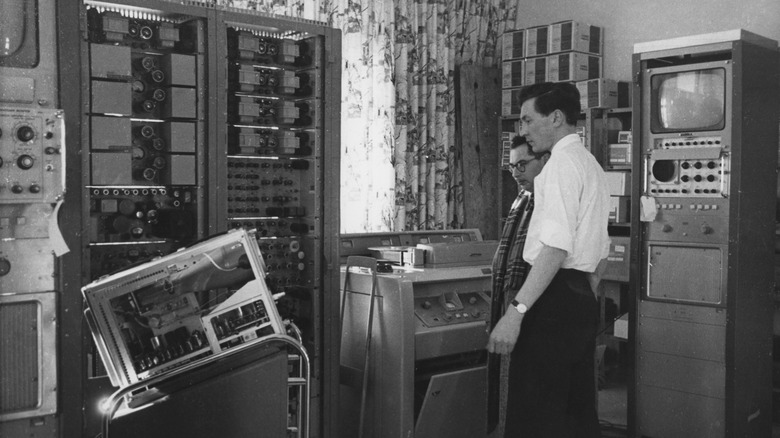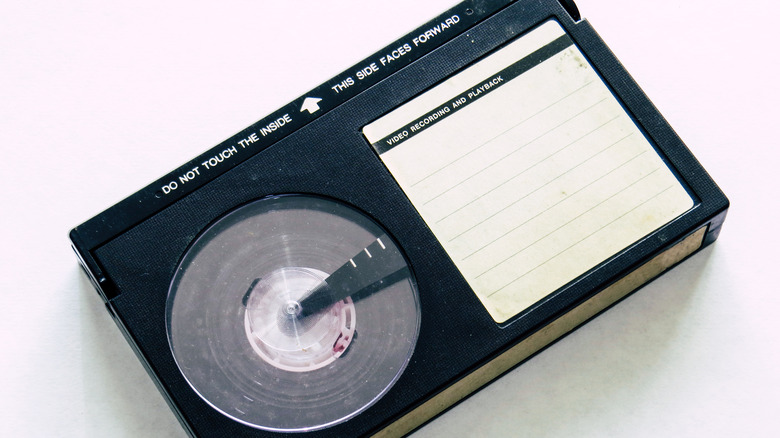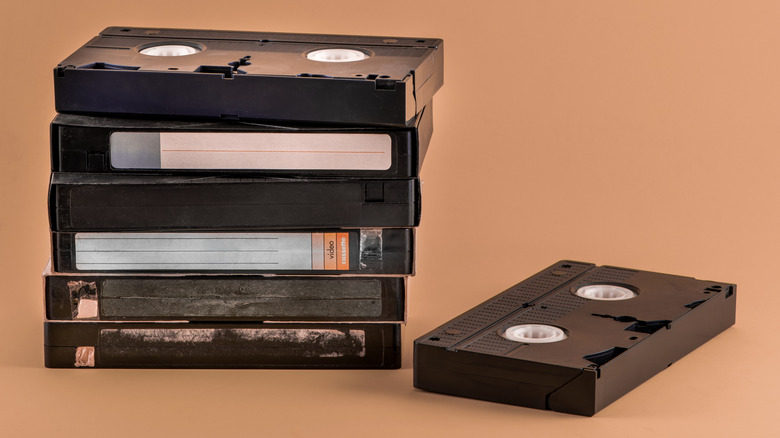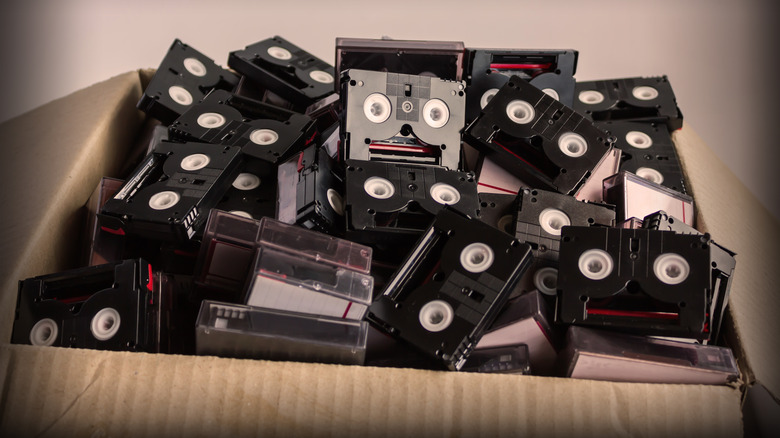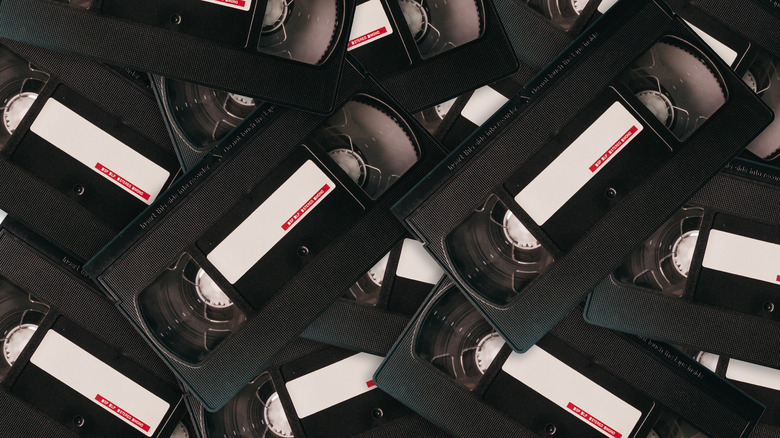The Untold Story Of The Videotape Format Wars
VHS tapes seem to define a generation. Whether it was by renting the clunky tapes of films from Blockbuster or recording a favorite show onto a blank tape at home, the VHS tape was a staple of the end of the 20th century.
But what if the VHS tape wasn't the first, or even the best videotape that was out on the market at the time? How did it end up becoming such a defining feature of everyday life? Is there a chance that something other than VHS would've entered the nomenclature?
The videotape format wars didn't take off until the 1980s, but as videotapes entered the consumer market in the late 1970s, the race was on. This wasn't the only technological format war in history, but it not only ended up revolutionizing the way people interact with media, but it also ended up being involved in a precedent-setting court case. And in this instance, it's clear who the winner was, since it's almost impossible to imagine how life may have been otherwise.
A brief history of the videotape
Although television signals were being recorded on tape by the end of World War II, it was an incredibly difficult process for the machines to play these signals. According to Smithsonian Magazine, In the late 1940s, television signals were recorded with audio tape recorders, which "[ran] the tape at very high speeds of up to 240 inches per second to achieve high-frequency response."
In 1951, Charles Ginsberg came up with an idea for a new machine that could play the tapes at a slower rate with "recording heads [that] rotated at high speed[s]," creating the first videotape recorder.
As a result, live broadcasts were soon replaced by recorded programs and in 1956, CBS became the first network to use videotape recording technology, when the first commercial videotape format was introduced in the United States, writes Obsolete Media. Known as the Quadruplex, or 2-inch Quad, this tape format was introduced by Ampex and became the standard for broadcasting for almost 30 years.
However, WIPO Magazine writes that the first magnetic tape video recorder was priced at $50,000 (a whopping $325,000 today), which meant that it was way out of the price range for the typical consumer.
What was Betamax?
The Beta Tape, also known as Betamax, was introduced to the United States and Japanese market by Sony in 1975. In 1978, it was introduced to the United Kingdom market as well. Aimed at being an analog video format for the general consumer, the tapes initially had a one-hour recording capacity, according to Obsolete Media.
Although Sony eventually made tapes that had a longer recording time by 1977, when VHS tapes hit the market, according to Paste Magazine, there was some loss of quality However, at the end of the day, Betamax tapes were considered to have better color and more image stability while playing.
Engineer Guy also notes that ejecting a tape with a Betamax was significantly smoother and wouldn't "wear out the mechanism." One of the reasons that Betamax offered a better quality picture was because both the tapes and the players were built by Sony "or companies closely monitored by Sony."
But if Betamax was such a good product, then what did VHS tapes have to offer? And why isn't Betamax more well-known?
Enter VHS by JVC
The Video Home System, also known as VHS, was released by JVC in Japan in 1976, and in 1977, it reached the United States and the United Kingdom. When they were initially released, VHS tapes had a recording time of two hours, double that of the Betamax. Engineer Guy writes that VHS machines were also almost seven pounds lighter than the Betamax machine, and ended up being comparatively cheaper than Betamax Machines. The first Betamax machines cost around $2,000 just for the basic models, while the first VCRs for VHS tapes cost only about $1,000, per South Tree Blog.
According to Wired, one of the main differences was the fact that JVC licensed their VHS technology to anyone so that other electronic makers could make their own VCRs. This led to price competition and drove down prices in the VHS market.
The fact that Betamax and VHS weren't compatible led to what is known as the videotape format war. And although Sony tried to innovate technology and extend the time on their tapes, as JVC did the same, Betamax was never able to catch up ahain, explained Paste Magazine. Nowadays, it's pretty clear who the winner was because the majority of people haven't even heard of Betamax. But at the time, Betamax was in the lead enough to be the subject of a United States Supreme Court case that would set a precedent on copyright infringement and ultimately, allowed VHS to swoop in and overtake the market.
The Betamax case
In 1976, Sony was sued by Universal City Studios in response to their newly released Betamax tapes. According to Oyez, Universal Studios argued that Sony was liable for copyright infringement because their Betamax tapes were being used to record copyrighted Universal Studio works.
If the Supreme Court had sided with Universal Studios, this would've meant that home recording could've essentially been made illegal, per The Atlantic. A solution may have been requiring VCR manufacturers to get a license "from any content owners whose programs might be recorded," writes Marquette University Law School, but this would've been at an enormous cost to the VCR manufacturers.
TechCrunch writes that although Sony won in 1979 in a district court, the Court of Appeals for the Ninth Circuit sided with Universal Studios. This led Sony to appeal the case to the Supreme Court, which agreed to hear the case in 1982. In a surprising turn of events, the Supreme Court not only listened to the oral hearing, but they allowed "both sides to re-argue a portion of the case." Under Chief Justice Warren Earl Burger, who was hearing the case, this had only ever happened in less than 3% of cases that were presented with an oral argument.
In the end, this is what led to Sony's victory in the court case, since the justices were initially planning to side with Universal Studios, but after hearing both sides reargue, the vote ended up being 5-4 in favor of Sony.
Why did VHS win?
Although Betamax continued to be sold in the United States until 1993 and held out in Japan until 2002, according to Obsolete Media, unfortunately by 1988, it was pretty clear to Sony that they'd lost the videotape format war. But what exactly was it that made VHS beat out Betamax?
The lower price point certainly helped, as did the longer recording time. And although Betamax was known for its superior image, at the time it seemed as though consumers were more interested in quantity rather than quality. But it's difficult to say what the deciding factor was and at the end of the day, when you take everything together, Betamax almost didn't stand a chance.
According to Macworld, some believe that the pornography industry had a hand in helping VHS come out on top. Steve Hirsch, founder of Vivid Entertainment in 1984, claimed that since VHS tapes were selling for $50 while Betamax went for $55, "we pushed VHS harder, and in that sense we did have something to do with VHS winning out."
But porn shouldn't get all of the credit. Ultimately, JVC's decision to open up the licensing of their VHS technology allowed it to be more open while Sony tried to maintain control of every part of the process. This affected everything from price to accessibility, which won out at the end of the day, even when people were faced with a technically better product.

